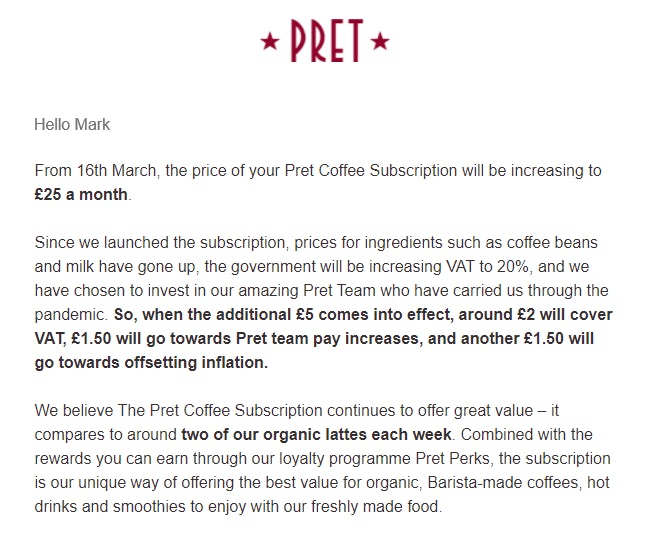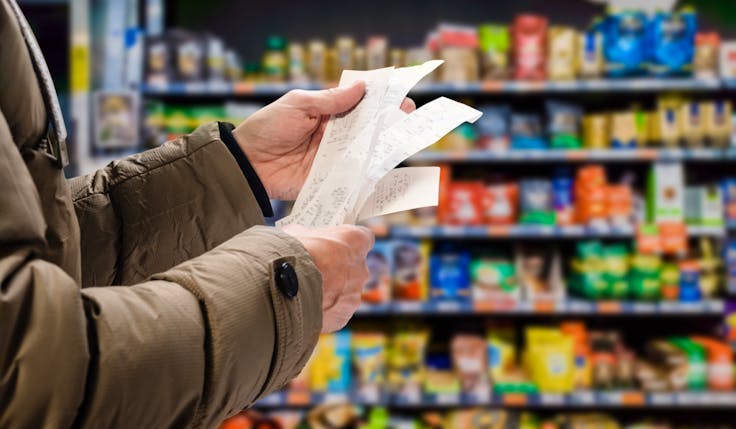An ethnography of pricing: How and why marketers should put up prices
Inflation means price increases are marketing’s number-one priority for 2022. But how many marketers are capable or even aware of the challenge ahead? Our columnist provides a handy cheat sheet for those who want to get it right.

My PhD thesis was about advertising. Specifically, supplementing the question ‘What does advertising do to consumers?’ with the additional perspective of ‘What do consumers do with advertising?’.
My brilliant PhD supervisor, Professor Richard Elliott, wanted me to use ethnography to watch kids as they used and applied advertising in their everyday lives. He had a hair-brained scheme that at only 24 I could still pass for a teenager, infiltrate a local secondary school and gather my data that way.
Things did not quite go to plan. In the end I got all my ethnographic data from six long months working as a teaching assistant at various secondary schools Up North. That data formed the basis for ‘The Social Uses of Advertising’, which was published, to a fair amount of acclaim, in one of the top American journals.
Tom Kerridge’s prices aren’t a rip-off if they’re what the market will pay
And it got me my first faculty job as an assistant professor at the University of Minnesota. A week into my new job, a middle-aged economist sidled up to me in the canteen and asked if I was the “Brit doing the ethno stuff”. When I confirmed this, he got quite excited and stole the rest of the lunch hour to spray me with big ideas (and quite a lot of his sandwich).
His name was Professor Mark Bergen. He had zero interest in advertising but was fascinated with the potential of ethnographic approaches to pricing. Bergen was half marketer, half economist. The economist in him loved all the things associated with pricing theory. The marketer abhorred the fact that most of it was rational, non-empirical stuff free from the dirty business of actual pricing. Bergen, and a troop of other economists that he would later assemble, wanted to use me and my method to look at pricing “in the wild”.
So later that year we ended up in Portland, Oregon at a huge B2B parts company studying how the company set and changed prices across the hundreds of components it sold. ‘Pricing season’, as the executives there called it, was a drawn-out affair. As I watched, and talked, and saw the process unfold, my new economist buddies got more and more excited. Many of the things that had been explained one way theoretically from 30,000 feet were happening for completely different reasons when studied from across the office floor.
Menu costs
And top of that list were menu costs. It was a simple concept for most managers. While a price rise is often desired at a company, the anticipated costs of executing that rise often dissuade a firm from making any changes. In a quote that made it into our final paper, one manager in Portland confessed that he would rather “take one in the pants” than endure the headaches, organisational changes, sales force tension, price sheet updates and customer angst that an increased price would almost certainly entail.
Seen in isolation, at a single firm, with a single SKU, this all made perfect, rational sense; the cost of changing price was deemed more taxing than the cost of keeping the existing price. But my increasingly excited gaggle of economists saw the bigger picture. One in which menu costs resulted in sticky prices, nominal price rigidity and a host of massive macro-economic implications. So massive that the economist George Akerlof would later win a Nobel Prize for his work in this area and cite our paper in Stockholm when he accepted it.
It has been a quarter-century since those ethnographic days in Portland. But the experiences and learnings have been on my mind a lot in recent weeks. Inflation is, for the first time in years, on the rise.
It’s a cliché to talk of a ‘perfect storm’ when discussing anything other than a flawless weather system, but in the case of UK inflation the metaphor is currently very apt. The slow recovery from Covid, the impact of Brexit, energy shortages and the spectre of war in the east are all combining to dramatically increase the rate of inflation.
In December, it jumped to its highest level in 30 years: 5.4%. It now sits at an estimated 5.7% and will likely rise to 6.6% by the next quarter. It’s a marker of the seriousness of the situation that almost no one who understands economics now puts Covid above inflation in the league table of economic challenges that this country faces.
A question of price
Specifically, this has a particular implication for companies and, if they are doing things right, the marketers that work for them. It’s time to increase prices. Perhaps several times. Of course many companies have already worked this out. An increase in the rate of inflation indicates that, by definition, many companies are already raising prices. But the bigger questions – down the supply chains of every industry and across every marketing department in this country – are whether your company is doing it and is doing it in the right way.
The likely answer for many marketers is either “no” or “what?” or “NFTs”. Over the last decade we have seen pricing largely disappear from the tactical skill set of most marketers. Gradually, with the erosion of proper training and the general dummification of marketing, the discipline has suffered three major ignominies.
First, the presence of proper strategy as part of the marketing process has been redacted to the point were most marketing is simply the brainless pursuit of tactics – I call this ‘tactification’.
Second, that abject focus on tactics ignores three of the main tactical joysticks of marketing (product development, pricing and distribution) and focuses exclusively on communication at the expense of a broader, more effective execution – I call this ‘communification’.
Third, that isolated perspective on just communications is further marginalised by the army of marketers who put the dreaded D-word in front of their title and then focus, bizarrely, on only half of the communications options, while ignoring the other side of the toolbox completely – I call this ‘digital marketers not fucking getting it’.
Marketers set prices too low because they look at the unit sales chart too much and ignore the profit chart on the next page.
The ramifications of this disastrous disciplinary triptych are huge and ongoing, but for 2022 the biggest one will be a deficit of marketers engaged in the urgent pricing discussions that occur in the months ahead. Clearly, pricing is not something exclusively controlled by marketers. My ethnographic research half a lifetime ago showed me the interdisciplinary necessity of having manufacturing, operations, supply chain, sales and marketing all around the table during various stages of the pricing season. But when marketers are absent from the room – as they so often are, either because they don’t know they are meant to be there or because they are too useless to get an invite – significant negative implications can accrue.
And, even when marketers are invited, there is a significant chance that they will get it wrong. Decades of exposure to marketers and pricing has taught me that most favour volume over value when it comes to pricing. Put more simply, they set prices too low because they look at the unit sales chart too much and ignore the profit chart on the next page. That same preoccupation with sales and ignorance of margin will ensure that many marketers in the months to come will dodge the price rise imperative, while pointing to healthy sales figures and a need for customer orientation as reasons to maintain prices at their current level.
That mistaken instinct is only likely to be emboldened as the media turns on companies that respond correctly to inflationary pressures and increase prices appropriately. As real incomes fall and budgets stretch, many corners of the idiot media are now ignorantly accusing companies of profiteering from a move that is about anything but. This recent exchange on CNN demonstrates exactly the problem. As do the comments from the supportive, nonsensical viewers beneath it.
“According to a transcript of their earnings call in January, company executives applauded their own company for raising prices…” pic.twitter.com/TaaK5Z6CmS
— Acyn (@Acyn) February 10, 2022
Ignore CNN, menu costs and your desire not to rock the consumer’s boat. Prices need to go up. And the trick is not just knowing how much to raise them but also how to raise them. When I teach pricing on the Mini MBA in Marketing I go to enormous lengths to delineate between the pricing approach of the company, the price that results and the manner in which it is then presented to the market.
These concepts might be connected but that does not make them one and the same. This single point, followed up by an awareness of the snakes and ladders of price increases and their impact on consumers, can be a marketer’s USP in the pricing discussions inevitably ahead at your organisation.
A cheat sheet on price increases
Utpal Dholakia is the man to listen to if you need a cheat sheet on the topic. He is a marketing professor at Rice University, who has spent his professional life examining the nexus between firms’ profitability and consumers’ motivations.
His advice is clear and important when it comes to the issue of inflation and pricing. Don’t hide your price increase in SKU size reductions or obfuscating alterations to blue-sheet price lists. Instead, be open and explicit about the move. Explain clearly when, well ahead of time, the increase will occur.
And that clarity also extends to the terminology too. Avoid euphemisms like ‘price adjustment’ or ‘price change’ because such things don’t lessen customer disappointment – if anything they exacerbate them. Use the term ‘price increase’ in all comms. Call a spade a spade. Or rather, from next Friday, a spade with a price increase.
That clarity and openness extends to the rationale for the increase too. Don’t dodge the issue of why prices are going up or use generic management speak to blur the explanation. Instead, create a short, specific explanation that cites the actual reasons for the price increase. If there is any good news to be had from the British economy right now, it is that there is an ocean of economic woe to plunder for the explanations of why your costs are going up and why your prices must therefore follow.
And, when you do make the explanation, try where legitimately possible to link the price increase to customer value. Too many marketers wank on about ‘storytelling’ to the point where I sometimes fear the discipline has become a semi-professional version of Jackanory. The challenge of price increase is, however, a specific opportunity to use powerful storytelling (the non-fictional kind) to genuinely help organisations handle one of the trickiest marketing challenges that they will face.
Keep it straight and simple. Couch it in terms the consumer can understand. And link it all back to delivering the value that attracted the customer to your brand in the first place.

When Pret-a-Manger launched its coffee subscription last year, many customers could not believe that £20 a month enabled them to effectively drink as much coffee as they wanted at almost any Pret location. But, like almost every other British company, Pret is now staring at significant cost increases that render its original subscription pricing unprofitable. So, the company emailed its current coffee subscribers to notify them of an increase in price (see image above).
Note the advanced notice of six weeks. Note the clear reference to a price increase. Note the simple, specific explanation for the increase. Note the way it avoids percentages or big numbers and presents all the cost increases on the level of each customer’s subscription. Note the focus on Pret employees, one of Pret’s great attractions, to further explain and legitimise the move. And note the final paragraph reminding everyone of the value of the offer.
More than anything else, look at the certainty and surety that Pret’s price communication provides. Consumers may not like the £5 increase but they are in no doubt, by the time they reach the bottom of the message, that it is going to happen in March. Such certainty is also important. Even the faintest dash of blood in the water when it comes to price increases can sow doubt in the mind of customers and create enormous workload for the sales team.
Utpal Dholakia’s advice is to approach the communication of price with the same degree of candour, commitment, attention to detail and customer concern that marketers typically bring to other aspects of tactical execution. Take, for example, the inane level of attention and involvement that most marketers exhibit for a press release or an event or an NFT launch and apply it to pricing. And remember that in so many contexts the sales team are the ones that deliver this message.
It’s no good crafting a beautiful, on-brand explanation for customers but leaving the field force, who see more customers in one week than you see in a whole year, to fend for themselves once you launch it. Brief them before you speak to customers.
One final note of caution: even if you get the price increase right and communicate it perfectly, you will still get customer blowback. Pret certainly received their fair share last week. A small subset of customers will always blast your decision on social media, accuse you of abject capitalist greed, and claim they will never buy from you again.
@Pret had been contemplating cancelling subscription due to the bitter and not nice coffee I’ve experienced over the past two weeks.
Well as predicted you are raising the price by £5, not paying more for poor coffee
so I’m off.— Carole Baker (@bakerboiler) February 3, 2022
Remember several important caveats here. First, you should have expected potentially lower unit sales when you opted to increase price. This was a move designed to protect profitability and not necessarily boost sales, at least in the shorter term. A few angry signals from angry customers are the broken eggs beside the lovely omelette of your new price.
Remember, too, that a handful of vocal social media voices does not a market make. If you’ve gone about your price increase the correct way, most consumers will accept it, they just aren’t likely to turn to social media to let the world know how impressed they are with their new higher price.
And finally, as has been proved time after time, social media is not only unrepresentative of the general market, it is often wildly unrepresentative of the person posting the message too. Twitter, Facebook, Instagram and TikTok are grand palaces of bullshit.
Use these caveats to further add value to your role and status inside the company. Forewarn everyone around the table to expect some customer complaints before they appear and help your company stick to its pricing guns once the increases are underway. You’ll not only be reminding everyone what a good marketer is meant to be able to do, you’ll be reminding them what a good marketer you are too.
And they are going to need you. The way things are going for 2022, this won’t be your company’s last price increase, so they will need you again down the track. As my marketing contact told me all those years ago in an office in Portland, Oregon: “Pricing season never really ends, it just goes into hiatus for a while.”
Mark Ritson teaches pricing on his Mini MBA in Marketing, which has increased its price from £1,450 to £1,525 for April. He is also the PPA Columnist of the Year and the British Society of Magazine Editors B2B Columnist of the Year.







